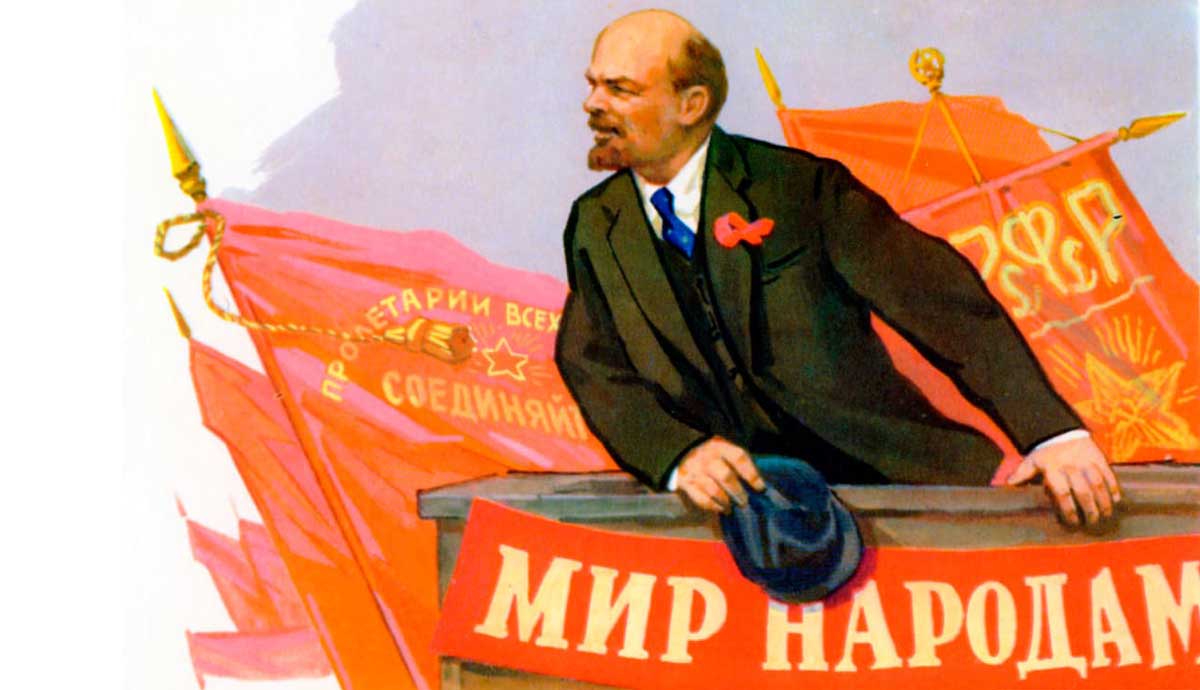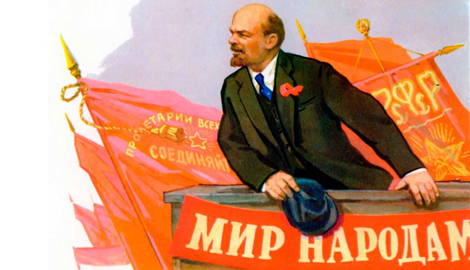
Vladimir Ilyich Ulyanov, better known as Lenin, was one of the most influential figures of the 20th century and, indeed, all of human history. He ushered in a new era of political action that would shake humanity’s understanding and implementation of ideology to its very core. Although dying at the relatively young age of 53, Lenin’s life was a continuous stream of important events shaped by the constant political upheaval surrounding him. From the late 19th century, Europe was teetering on the brink of revolution as ideas of class consciousness and class struggle competed against ideas of nationalism. The looming divisions of Europe would give way to internecine slaughter, and it is against this backdrop that Lenin was able to launch himself into the ultimate position of power in a new era that gave birth to the Soviet Union.
The success of the Russian Revolution in 1917 was not the end of Lenin’s story but the end of a chapter that heralded a very different and new phase in the life of Vladimir Lenin as Chairman of the Council of People’s Commissars of the Russian SFSR and the Soviet Union.
Vladimir Lenin & the Aftermath of the Revolution

The 1917 Revolution was a success. The Tsar had been deposed, and Russia was firmly in the hands of those who represented the working class. The transition, however, was not smooth. Vladimir Lenin’s Bolsheviks vied for power in the new political structure with various opponents, particularly the Socialist-Revolutionaries, who wanted to distribute wealth to the agrarian sector and give land to peasants rather than the urban proletariat. The biggest issue, however, was Russia’s participation in the First World War.
The Socialist-Revolutionaries saw continuing the war as necessary, while the Bolsheviks were adamant about defending their decision to secure peace with Germany via the Brest-Litovsk Treaty, in which Russia ceded significant lands to the Central Powers. The Socialist-Revolutionaries eventually pulled out of the government over the issue, and the Bolsheviks were left firmly in charge. From 1918 to 1919, the Bolsheviks consolidated their power, expelling Mensheviks and Socialist-Revolutionaries from the Soviet councils, effectively turning Russia into a one-party state.
As through all of Lenin’s life, these times were tumultuous. In January 1918 and March 1918, Lenin was the victim of assassination attempts, both of which he survived relatively unscathed.
The Russian Civil War

The terms of the Treaty of Brest-Litovsk had caused Russia to lose much to Germany, and as a result, counterrevolutionary sentiment was strengthened in the country. Further fueling these sentiments was the move away from relations with western powers, as many did not recognize the new Russian government. In addition to this, Vladimir Lenin made the decision to nationalize all foreign property. The government seized private property without compensation.
As a result of these consolidations, Russia descended into a five-year-long civil war that was extremely bloody and destructive. Another assassination attempt in August 1918 left Lenin in hospital with two bullet wounds. Lenin, however, survived, reportedly due to his robust constitution.
The civil war was fought between the Bolshevik “Reds” (commanded by Leon Trotsky) and the tsarist “Whites,” the latter being supplied with troops, equipment, and money from western nations. The US, Britain, Romania, France, and many others joined the fight, sending armies to defeat the Bolsheviks. There were also nationalist forces that fought against the Reds.

The most significant contributors in terms of manpower apart from the tsarist forces were Poland, which raised one million soldiers to fight the Reds, and Germany, which raised over half a million troops. Despite the economy collapsing, Lenin still managed to supply the Red Army. His leadership and determination furthered his cult of personality, inspiring Red Army morale throughout the conflict. Although a few of the nationalist movements won victories, by June 1923, the tsarists had been comprehensively defeated by the Red Army. The damage caused by the war, however, was horrific. It is estimated that between seven and twelve million soldiers and civilians died as a result of the conflict.
After the defeat of Germany, its forces retreated back to the German heartland, leaving a power vacuum between Russia and Germany. The newly-created Polish state and Russia both vied for land, and the two nations came to blows. The Polish invaded Ukraine and were defeated by Soviet forces. In response, Lenin urged an attack on Warsaw, believing that the proletariat would rise up and overthrow the Polish government. Lenin miscalculated, and this expectation did not happen. Soviet Armies were defeated in Poland.
Likewise, revolutions across Europe failed to materialize as Lenin had hoped. Nevertheless, Lenin created the Communist International (COMINTERN) to export the revolution and promote communist sentiment internationally.
Crackdown on Threats to the Revolution

From even before the civil war, and indeed the Revolution itself, there were components of Russian society that were seen as threats to the success of Bolshevism within the country. Various enemies were identified, along with methods constructed to root out and eliminate these threats.
Among these threats from the very beginning of Vladimir Lenin’s rule was the “Kulaks”: peasants who had grown rich from hoarding grain. Russia was facing severe food shortages and famine, and as such, the Kulaks were targeted with intense ferocity for having put the Revolution in a considerably unstable position. Committees of Poor Peasants were set up by the government and were sanctioned to carry out executions of those hoarding grain. However, the control of these mobs was limited and spiraled out of control. Many non-Kulaks were targeted. In addition, grain production slumped, and a thriving black market evolved.
Although the situation was difficult to control, Lenin was not opposed to using violence to extend the means by which the government should maintain order. He set up a political police force, the Emergency Commission for Combating Counter-Revolution and Sabotage (Cheka), to advance the will of Bolshevism. The Cheka was used to silence political opposition within and outside the Communist Party.
After the assassination attempt in August 1918, the activities of the Cheka increased further. Thousand of “class enemies” were silenced during a period known as the Red Terror that lasted until February 1922. Estimates vary on how many people were killed, from as few as 10,000 to as many as 2 million. No records were kept. The Tsarist forces also had their own period of political repression and execution known as the White Terror.
Fixing the Economy

The famine of 1921-1922 hit Russia hard, and millions died. In a bid to control the situation, grain was appropriated and distributed by the state, but there was simply not enough food. Peasant uprisings challenged Bolshevik rule, and clashes became widespread. The United States sent food aid, and although it was distributed, Lenin was highly suspicious of US intentions. The Russian government also reappropriated and sold property of religious institutions, leading to tension with the clergy.
The Russian economy was in poor shape, and to address this problem, Lenin implemented the New Economic Policy (NEP), which allowed for limited capitalist practices. Under this policy, small private enterprise was permitted, along with property ownership of small industries. Despite the adverse reaction from many Bolsheviks, who regarded the NEP as a betrayal of communist principles, the NEP succeeded in restoring the Russian economy.
Lenin’s Declining Health & Death

By the second half of 1921, Vladimir Lenin’s health became a significant issue. He began suffering from hyperacusis (inability to tolerate noise), constant headaches, and insomnia. The Politburo insisted that he take time off, and in July 1921, Lenin left Moscow to spend time in his house in Gorki, where he was attended to by his wife and a host of physicians. Despite the attention, doctors were unable to determine the cause of his suffering. During this time, Lenin still remained a powerful figure, influencing the governance of the state.
In May 1922, Lenin suffered a stroke but recovered quickly. He attempted to resume his duties in Moscow, but in December of the same year, he suffered another stroke and returned to Gorki. Fearing that death was near, Lenin wrote a testament during this period, detailing his distrust of Stalin and his wish for Trotsky to take over power after Lenin’s death.
In 1922, Lenin and Stalin had many disagreements. Of great importance was how nations like Georgia and Armenia were to be administered. Stalin wanted these countries to be merged into Russia. Lenin saw this as Russian arrogance and insisted on the states being incorporated as semi-independent republics within a greater union. Stalin finally relented and agreed to Lenin’s proposal, and the Union of Soviet Socialist Republics was born.
In March 1923, Vladimir Lenin suffered another stroke, and on January 21, he fell into a coma and died later that day. Against his wife’s wishes, his body was embalmed and remains on display in a mausoleum on the western side of Red Square.

Vladimir Lenin remains a widely controversial figure around the world. For some, he is a figure of communist oppression, while for others, he is a symbol of hope and a man who fought for equality and a better life for all human beings. However, it cannot be disputed that his legacy was a legacy of revolution that disrupted the existing power structures and set in motion a state of affairs that would define the 20th century and shape the world for centuries to come.










